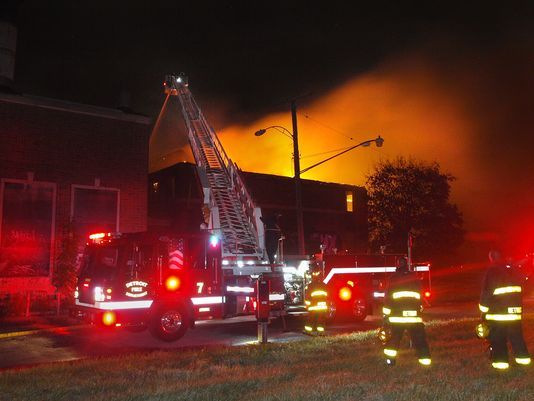Featured Articles
Boxing History Went Up in Flames in Blaze That Destroyed Kronk Gym
worked with 41 world champions, 30 of whom he helped develop at that city’s shrine to the sweet science, the Kronk Gym, the most famous alumnus

As a trainer, the late, great Emanuel Steward always believed he could help guide his prized pupils to victory when everything seemingly was on the line. That sense of supreme confidence proved more than justified as Steward, sometimes referred to as the “Godfather of Detroit boxing,” worked with 41 world champions, 30 of whom he helped develop at that city’s shrine to the sweet science, the Kronk Gym, the most famous alumnus of whom is five-division world titlist Thomas Hearns, who turned his career and, more importantly, his life, over to his beloved father figure when the future “Hitman” was just a scrawny boy with a grown-up dream.
“The man changed my life. He made me a different person. I owe him a great deal, more than I can ever repay,” Hearns, now 58, said upon learning that Steward had passed away at 68 on Oct. 25, 2012, after undergoing surgery for diverticulitis in Chicago, a procedure made more precarious by a weakened Steward’s ongoing battle with colon cancer.
“Manny told me as a kid I’d be a world champion someday,” Hearns continued. “He molded me, shaped me. Manny had the eye (for spotting talent).”
On Sunday morning, Hearns, again visibly distraught, stood before the burnt-out husk of the facility where, under Steward’s patient tutelage, he and so many other elite or near-elite boxers – Hilmer Kenty, Milton and Steve McCrory, Jimmy Paul, Duane Thomas, William “Caveman” Lee, Michael Moorer and Gerald McClellan among them – had heard and followed their shared destiny. Given the ravages of time and indifference that had taken place since the Kronk Gym was closed by the City of Detroit, which lacked the wherewithal to make needed improvements or even to keep it open as-is, such an ending for the onetime civic treasure probably was inevitable.
David Fornell, a deputy commissioner with the Detroit Fire Department, said the blaze was called in at 9:25 on Saturday night and that it was “suspicious” enough to warrant an investigation as to its cause. Firefighters were on the scene for 4½ hours, but their good intentions to enter the graffiti-defaced building were thwarted by fear that the roof would collapse, which it eventually did. Regardless of whatever information the investigation yields, there is no chance of another boxing gym, and little chance of anything else, rising on that site.
“It’s just sad that people didn’t value this place like we did,” Hearns told the Detroit Free Press. “What this building brought to me was a chance at life. I got a chance to become somebody out of this building right here. This was a safe haven to me.”
Sylvia Steward-Williams, Steward’s daughter, seconded Hearns’ sense of personal loss, telling the Detroit News that “my father’s heart lived in that gym. He’d still pay for it (the property) even after we moved out because his heart was so much with those kids who wanted and needed that space to train. We never expected this. It’s devastating.”
Built in 1921 and named for a Detroit city councilman named John Kronk, the Kronk Gym, located in the basement of the since-shuttered Kronk Community Center on Detroit’s economically depressed west side, was never a showplace even in the best of times. It was merely functional, and, truth be told, it did not age gracefully. By the time Steward was named its director of boxing in 1971, the paint had already begun to peel off the walls and the non-air-conditioned building could be insufferably hot during the summer. But the tools of a boxer’s trade were inside, and none of the aspiring champions complained much about the lack of amenities because, hey, they weren’t there to be comfortable. They came to learn, and the main man doing the teaching was Steward, a former Detroit Golden Gloves titlist whose gift for imparting knowledge to his young charges soon would become legendary.
In his own way, Steward had been as much of a student as were Hearns and the other kids who wore Kronk’s gold-and-red colors as a distinctive badge of honor. Born in Bottom Creek, W.Va., little Manny moved with his family to Detroit when he was a child and he was taught to box by Luther Burgess, a disciple of the venerable Eddie Futch, at the Brewster Community Center, where the iconic heavyweight champion Joe Louis honed his craft. The Brewster was, in a sense, the Kronk Gym before there was a Kronk Gym.
“The Brewster is on the east side of town right in the middle of the Brewster Projects,” Steward told Newark Star-Ledger sports columnist Jerry Izenberg in 1992. “The east side was poor then and it’s poor now. But when I was growing up, every kid in Detroit knew that Joe Louis trained there.”
And so it would be with the Kronk, with Hearns serving as its Joe Louis and Steward as its Eddie Futch. But as the Kronk’s neighborhood slowly withered away, and the number of kids who had once flocked there to tug on their first pair of boxing gloves decreased, Manny’s role transformed from that of stay-close-to-home professor to roving troubleshooter for hire. Instead of getting in on the ground floor with young fighters he accompanied all the way to the top, he applied his magical touch when requested to such seasoned pros as Lennox Lewis, Evander Holyfield, Julio Cesar Chavez, Oscar De La Hoya, Miguel Cotto and Wladimir Klitschko.
But the struggling Kronk Gym was never far from Steward’s thoughts, and he undertook several initiatives to raise enough money to keep it operational and, hopefully, more than that. But what Steward did not have was unlimited financial resources or as much success at rallying local support for the city-owned gym as he had in developing such homegrown ring stars as Hearns, Kenty and the McCrorys.
“Without additional funding, the Kronk Recreation Center will simply not be able to remain open,” Manny told me in January 2006. “Shuttering the Kronk Gym would be devastating to Detroit and the youth of this city.”
But Detroit had priorities then, and it still does, and some of those supersede an expensive-to-maintain gym where young boxers can learn the proper way to hook off the jab. As Fornell, the deputy fire commissioner, noted, the loss of the Kronk Gym is “a part of history that was destroyed” and “it’s unfortunate that we are losing these architectural gems, but also, they’ve been vacant for years. Nobody stepped up. Right now the city is working on getting street lights, lowering response times (for calls to the police and fire departments). There are a lot of priorities in the city.”
Makes sense from a strictly practical standpoint, but still one wonders why boxing – as much a part of Detroit’s identity as, say, a chart-topping song – was given such relatively short shrift in comparison to Motown, where a visionary named Berry Gordy Jr. served as the rhythm-and-blues counterpart to Steward and was accorded so much higher a place of distinction in the city’s sense of self-identity. Motown, also known as “Hitsville USA,” was founded by Gordy in 1959 and served as the springboard to superstardom for such performers as the Supremes, the Four Tops, the Temptations, Smokey Robinson and the Miracles, Martha and the Vandellas and Mary Wells. Although Gordy moved his operation to Los Angeles in 1972, the original Motown headquarters at 2648 West Grand Blvd. since 1985 has housed a museum that has become a popular tourist destination, located on the renamed Berry Gordy Jr. Blvd.
Tight operating budget or not for the City of Detroit, fight fans will continue to wonder why no such effort was undertaken to commemorate the life and times of the much-beloved Steward, and to preserve, to some minimally acceptable degree, the proving ground from which he sent Hearns and his Kronk brethren forth to proudly carry the municipal banner.
Then again, other cherished heirlooms of boxing have also been allowed to go fallow or to be removed altogether. The 5th Street Gym in Miami Beach, where Cassius Clay (Muhammad Ali) trained for his first fight with Sonny Liston, was partially razed and dormant from 1992 to 2009 when it reopened with little fanfare. The Grand Olympic Auditorium in Los Angeles, site of the 1932 Olympic boxing competition, was purchased in June 2006 and now houses the Glory Church of Jesus Christ, a Korean-American congregation. Philadelphia’s Sesquicentennial/Municipal/John F. Kennedy Stadium, where Gene Tunney wrested the heavyweight championship from Jack Dempsey on Sept. 23, 1926, and Rocky Marciano seized it from Jersey Joe Walcott exactly 26 years later, was demolished in 1992 to clear the ground on which the Wells Fargo Center now sits. And the Blue Horizon in Philly has, like the Kronk Gym, been shuttered and decaying for a decade now.
Boxing will survive because, hey, it always does. But the fire that consumed the Kronk Gym left in ashes more than what had become a dilapidated building. It burned a hole in the fabric of fight fans’ collective memories, and all we can do, like Tommy Hearns, is shed a tear for what once was and can never be again.
Above the Kronk rec center as it appeared in 2006 before vandals rendered it uninhabitable. The boxing gym was in the basement.
Check out more boxing news on video at The Boxing Channel.
-

 Featured Articles4 weeks ago
Featured Articles4 weeks agoAvila Perspective, Chap. 330: Matchroom in New York plus the Latest on Canelo-Crawford
-

 Featured Articles3 weeks ago
Featured Articles3 weeks agoVito Mielnicki Jr Whitewashes Kamil Gardzielik Before the Home Folks in Newark
-

 Featured Articles8 hours ago
Featured Articles8 hours agoResults and Recaps from New York Where Taylor Edged Serrano Once Again
-

 Featured Articles4 weeks ago
Featured Articles4 weeks agoCatching Up with Clay Moyle Who Talks About His Massive Collection of Boxing Books
-

 Featured Articles5 days ago
Featured Articles5 days agoFrom a Sympathetic Figure to a Pariah: The Travails of Julio Cesar Chavez Jr
-

 Featured Articles3 weeks ago
Featured Articles3 weeks agoMore Medals for Hawaii’s Patricio Family at the USA Boxing Summer Festival
-

 Featured Articles7 days ago
Featured Articles7 days agoCatterall vs Eubank Ends Prematurely; Catterall Wins a Technical Decision
-

 Featured Articles4 weeks ago
Featured Articles4 weeks agoRichardson Hitchins Batters and Stops George Kambosos at Madison Square Garden




















